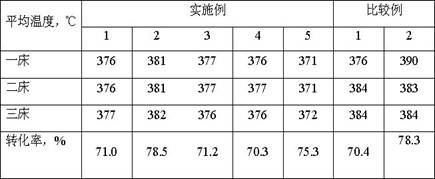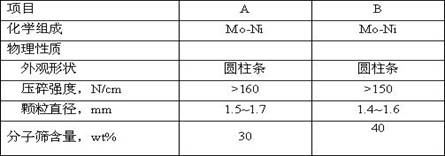Methods of Improving the Smooth Operation of Hydrocracking Units
A hydrocracking, stable operation technology, applied in chemical instruments and methods, hydrotreating processes, molecular sieve catalysts, etc., can solve the problems of damaged hydrocracking catalyst activity, mismatched reaction temperature, etc., and achieve good passivation effect. , The effect of suitable process conditions and simple process
- Summary
- Abstract
- Description
- Claims
- Application Information
AI Technical Summary
Problems solved by technology
Method used
Image
Examples
Embodiment 1
[0053] When the reaction temperature of the hydrocracking catalyst first bed is 376 ° C, and when the exit temperature of the first catalyst bed and the inlet temperature difference T1 are 4 ° C, the nitrogen weight content of the catalyst in the first catalyst bed is 0.25%, Cooling to 315 ° C refined oils in a nitrogen content of 460 ppm, and the nitrogen content of the liquid phase fluid phase fluid phase is constant to 50 ppm, and the nitrogen content is from ~ 20 ppm hydrotherminal oil, and then first improve the reaction temperature to 365 ° C Temperature adjustment, the control conversion rate is constant to 35%, stable for 48 hours; continue to adjust the reaction temperature, the control conversion rate is constant to 50%, stable for 48 hours; continue to adjust the reaction temperature, the control conversion rate is constant to 55%, stable 48 hours Finally, the process conditions entered normal production, and the depth of the control was the same as Comparative Example ...
Embodiment 2
[0055] When the reaction temperature of the hydrocracking catalyst is 377 ° C, and when the outlet temperature of the first catalyst bed and the inlet temperature difference T1 are 5 ° C, the nitrogen content of the catalyst in the first catalyst bed is 0.24%, cooling. To 322 ° C 320 ppm of refined oils, the nitrogen content of the liquid phase fluid phase to be cracked is constant to 50 ppm, and the nitrogen content is from ~ 20 ppm hydrotherminal oil, and then first improve the reaction temperature to 365 ° C Temperature adjustment, constant control conversion rate is 35%, stable 24 hours; continue to adjust the reaction temperature, control conversion rate is 45%, stable for 48 hours; continue to adjust the reaction temperature, control conversion rate is 55%, stable 48 hours Finally, the process conditions entered normal production, and the transformation depth of its control was the same as Comparative Example 2.
Embodiment 3
[0057] When the reaction temperature of the hydrocracking catalyst first bed is 377 ° C, and when the outlet temperature of the first catalyst bed and the inlet temperature difference T1 are 3 ° C, the nitrogen content of the catalyst in the first catalyst bed is 0.30%, cooling. When the nitrogen content of 400 ppm is 318 ° C, the nitrogen content of the liquid phase to be cleaved is constant to 80 ppm, and the nitrogen content of ~ 20 ppm is 3 ppm, and then the reaction temperature is first improved to 365 ° C. Temperature adjustment, the control conversion rate is constant to 35%, stable for 48 hours; continue to adjust the reaction temperature, the control conversion rate is constant to 50%, stable 24 hours; continue to adjust the reaction temperature, the control conversion rate is constant to 55%, stable 24 hours; Finally, the process conditions entered normal production, and the translation depth of its control was the same as Comparative Example 1.
PUM
| Property | Measurement | Unit |
|---|---|---|
| density | aaaaa | aaaaa |
Abstract
Description
Claims
Application Information
 Login to View More
Login to View More - R&D
- Intellectual Property
- Life Sciences
- Materials
- Tech Scout
- Unparalleled Data Quality
- Higher Quality Content
- 60% Fewer Hallucinations
Browse by: Latest US Patents, China's latest patents, Technical Efficacy Thesaurus, Application Domain, Technology Topic, Popular Technical Reports.
© 2025 PatSnap. All rights reserved.Legal|Privacy policy|Modern Slavery Act Transparency Statement|Sitemap|About US| Contact US: help@patsnap.com



